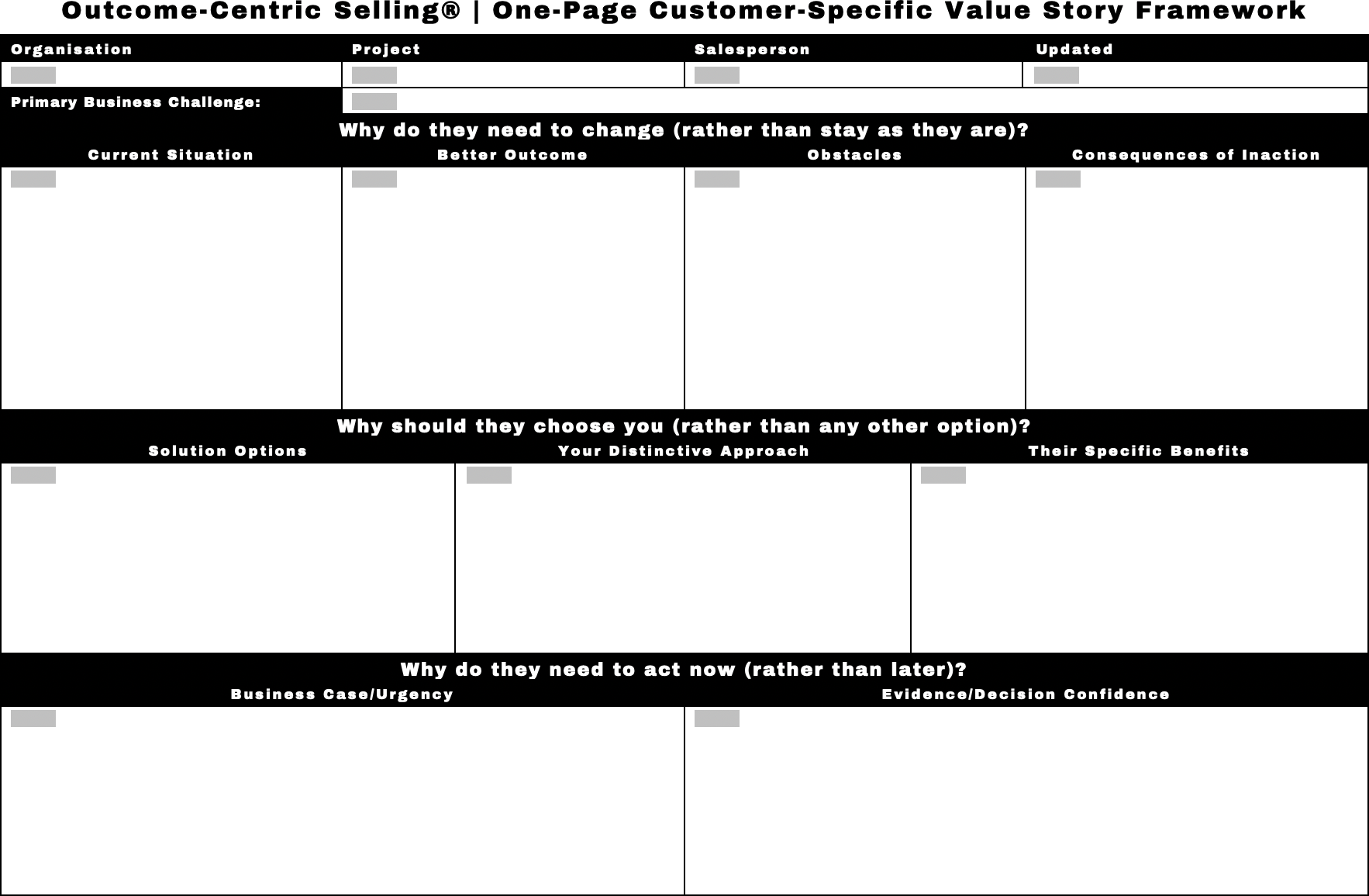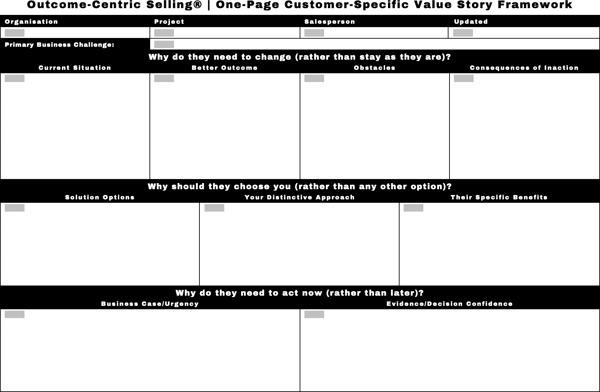Answering your customer’s three critical questions
July 1, 2020

 In today's challenging and uncertain business climate, your customers have good reason to be cautious. They are unlikely to initiate new projects unless they see them as being strategically relevant, tactically urgent, and capable of delivering rapid time-to-value. The rest can wait.
In today's challenging and uncertain business climate, your customers have good reason to be cautious. They are unlikely to initiate new projects unless they see them as being strategically relevant, tactically urgent, and capable of delivering rapid time-to-value. The rest can wait.
If your sales organisation are to break through the deadlock, they must develop compelling answers to their customer's three critical questions:
- Why should they change?
- Why should they choose you?
- Why should they act now?
If your answers to any of these questions are less than completely compelling, the chances are your customer will stick with the status quo. Generic value propositions are not going to be much help - your salespeople need to learn how to craft customer-specific outcome-centric value stories...
Why Change > Why You > Why Now?
Each of these three questions needs to be broken down into its constituent parts - and if any of these components are weak or missing, your chances of winning their business are likely to be compromised.
Why Change?
In most complex B2B environments, and particularly if your customer is considering a discretionary - as opposed to an inevitable - purchase your most powerful competitor is probably not another similar vendor, but the status quo.
Until and unless - hopefully with your help - your customer concludes that staying on their current path would be dangerous and that they have to change direction, they are unlikely to take action. So, the first question they need to answer is why they should change.
You need to understand four things if you are to persuade them of the need for change:
Current situation
First, you need to understand their current situation, and the trajectory they are currently following. What’s going on in their business and in the world around them? What is working, and what isn’t working? What are they comfortable with, and what are they concerned about?
Expected outcomes
Then, you need to understand where they need to get to, and what they want to change. What are the outcomes they need to achieve, and how will they know they have reached them? What are the metrics they will use to measure their progress towards their goals?
Needless to say, if there is only a small gap between their current situation and their expected outcomes, they are likely to continue on their current path. But if they see a large and growing gap between their current situation and their expected outcomes, they are far more likely to accept the need for change.
Obstacles
Even if there is a large and growing gap between where they are and where they need to be, unless they perceive obstacles along the way, they are unlikely to recognise the need for external help. Your goal must be to help them to acknowledge roadblocks that they cannot eliminate without external help - preferably yours.
Cost of Inaction
Finally, in order to make the case for change, the customer - with your assistance - must recognise that there are serious and growing costs and consequences associated with sticking with the status quo. They must be convinced that the costs of inaction are more far significant than any risk associated with change.
Why You?
You now need to convince them that you are the best partner to help them achieve the change they recognise they need to achieve. Your competition may not just be other similar vendors: in many situations, your “solution” will also be evaluated against an in-house initiative.
You therefore need to understand three things if you are to persuade them to choose you:
Solution Options
What do they regard as their credible solution options? Bear in mind that these may include using their own in-house resources. Which options are they likely to shortlist? What will be their key decision criteria? How do they perceive your offering compared to these other options?
Your Distinctive Approach
In the current climate of rapid competitive development, feature-led differentiation is hard to establish, even harder to sustain and rarely ever more than transitory. That’s why you need to differentiate yourself on the basis of your vision, your approach and your track record. What sets your organisation apart from all their other options?
Your Unique Benefits
And how does this distinctive approach translate into specific, relevant benefits to the customer? What could they achieve with your help that they would struggle to accomplish under any other option? And how does this translate into specific, measurable business outcomes?
Why Now?
But even if the customer is convinced of the need for change, and even if they believe that you represent their best possible option, they may still not commit to immediate action unless they feel a sense of urgency.
There are two more things required to complete their value story:
Business Case/Urgency
What are their investment criteria (which may of course have changed recently in response to the current crisis) for new projects? And what does their internal business case for this project look like? Is it strong enough to ensure approval? And what about the cost of inaction - is it painful enough to drive urgency?
Evidence/Decision Confidence
Last but by no means least, what evidence can you offer to support the need for change, the unique benefits of your approach, and the need for urgent action? How can you give them the confidence that their expected outcomes will be achieved, and that their least risky option is not to stay put, but to take decisive action now?
In conclusion
As you can imagine, having a clear, compelling and complete value story is the perfect foundation for the all-important executive summary of a proposal that will compel them to take action. It can confirm that your proposed solution is strategically relevant, tactically urgent and will deliver rapid time to value.
We’ve created a simple one-page framework that helps to ensure that you have captured every element of your outcome-centric, customer-specific value story.

Your chances of winning with such a value story are far higher than if your proposal merely makes the case for your company and your offerings. Without a compelling value story, your project risks (at best) being deferred. At worst, you may never win the business.
So, wouldn’t it make sense to ensure that you had established the foundations for compelling value story, answering “why change, why you and why now?” before you invested significant resources in pursuing an opportunity that was never there in the first place, or never winnable if it was?
Drop me a line if you’d like an editable copy of the value story template.
A version of this article was first published on LinkedIn.
ABOUT THE AUTHOR
 Bob Apollo is a Fellow of the Association of Professional Sales, a founding contributor to the International Journal of Sales Transformation, an active member of the Sales Experts Channel and the Sales Enablement Society, and the driving force behind Inflexion-Point Strategy Partners, the leading proponents of outcome-centric selling.
Bob Apollo is a Fellow of the Association of Professional Sales, a founding contributor to the International Journal of Sales Transformation, an active member of the Sales Experts Channel and the Sales Enablement Society, and the driving force behind Inflexion-Point Strategy Partners, the leading proponents of outcome-centric selling.
Following a successful corporate career spanning start-ups, scale-ups and market leaders, Bob now works as a strategic advisor, mentor, trainer and coach to ambitious B2B sales organisations - teaching them how to differentiate themselves through their provably superior approach to achieving their customer's desired outcomes.


Comments